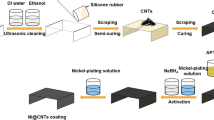Abstract
Layer-by-layer depositions of nickel and copper with nano-sized thickness were well formed by two-step pulsation at pH 4.5. The multi-layers were composed of a copper-rich nickel phase of 8: 2 with 14-nm thickness and a nickel-rich copper phase of 9: 1 with 16-nm thickness, respectively. The Ni2+-citrate solution controls the optical and chemical properties of the Cu2+Ni2+-citrate solution. The absorbance change with pH was related to complex formation. The relative contents of nickel and copper of an electroplated layer depended on electroplating conditions like the current density and pH. The electromagnetic shielding efficiency of the copper-nickel composite mesh/PI film showed more effective electromagnetic interference (EMI) shielding properties than a pure copper mesh/PI film in the GHz frequency range.
Similar content being viewed by others
References
A. Turonova, M. Galova, and M. Supicova, “Parameters influencing the electrodeposition of a Ni-Cu coating on Fe powders. I. Effect of the electrolyte composition and current density,” J. Solid State Electrochem. 7, 684–688 (2003).
H. V. Venkatsetty, “Electrodeposition of thin magnetic permalloy films,” J. Electrochem. Soc. 117, 403–407 (1970).
V. Tutovan and N. Velican, “Magnetic properties of electrodeposited NiCo thin films,” Thin Solid Films 7, 219–227 (1971).
J. P. Celis, P. Cavallotti, J. M. da Silva, and A. Zielonka, “The future for electroplating electromagnetic materials in microelectronics,” Trans. IMF 76(5), 163–170 (1998).
D. Tench and J. White, “Tensile properties of nanostructured Ni-Cu multilayered materials prepared by electrodeposition,” J. Electrochem. Soc. 138, 3757–3758 (1991).
K. D. Bird and M. Schlesinger, “Giant magnetoresistance in electrodeposited Ni/Cu and Co/Cu multilayers,” J. Electrochem. Soc. 142, 65–66 (1995).
A. L. Greer and R. E. Somekh, Materials Science and Technology, A Comprehensive Treatment, Ed. by R. W. Cahn, P. Haasen and E. J. Kramer (VCH. Weinheim, 1984), Vol. 15,Chap. 8, pp. 329–370.
I. G. Casella, “Electrodeposition of cobalt oxide films from carbonate solutions containing Co(II)-tartrate complexes,” J. Electroanal. Chem. 520, 119–125 (2002).
E. Beltowska-Lehman and P. Ozga, “Effect of complex formation on the diffusion coefficient of CuII in Citrate Solution Containing NiII and MoVI,” Electrochim. Acta 43, 617–629 (1998).
Ch. Bonhote and D. Landolt, “Microstructure of NiCu multilayers electrodeposited from a citrate electrolyte,” Electrochim. Acta 42, 2407–2417 (1997).
J. Crousier and I. Bimaghra, “Effect of nickel on the electrodeposition of copper,” J. Appl. Electrochem. 23, 775–780 (1993).
T. A. Green, A. E. Russell, and S. Roy, “The development of a stable citrate electrolyte for the electrodeposition of copper-nickel alloys,” J. Electrochem. Soc. 145, 875–881 (1998).
Y. Choi, “Effect of annealing on the wear properties of amorphous chrome-plated steel,” J. Mater. Sci. Lett. 15, 629–631 (1996).
N. V. Mandich, “Chemistry and theory of chromium deposition. Part I: Chemistry,” Plat. Surf. Finish. 84, 108–115 (1997).
Y. Choi, “Electro-deposition behaviors of trivalent chromium during pulse plating,” Met. Mater. Int. 16, 755–760 (2010).
E. Chasseing and K. V. Quang, “Mechanism of copper-nickel alloy electrodeposition,” J. Appl. Electrochem. 17, 1267–1280 (1987).
Author information
Authors and Affiliations
Corresponding author
Additional information
The article is published in the original.
Rights and permissions
About this article
Cite this article
Song, C.H., Choi, Y., Lee, JY. et al. Electro-magnetic insulating behavior of thin multilayered copper-nickel composite mesh sheet formed by two-step pulse electroplating. Phys. Metals Metallogr. 115, 1275–1280 (2014). https://doi.org/10.1134/S0031918X14130237
Received:
Accepted:
Published:
Issue Date:
DOI: https://doi.org/10.1134/S0031918X14130237




